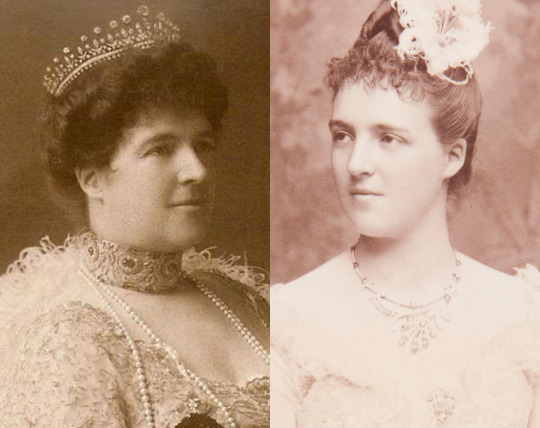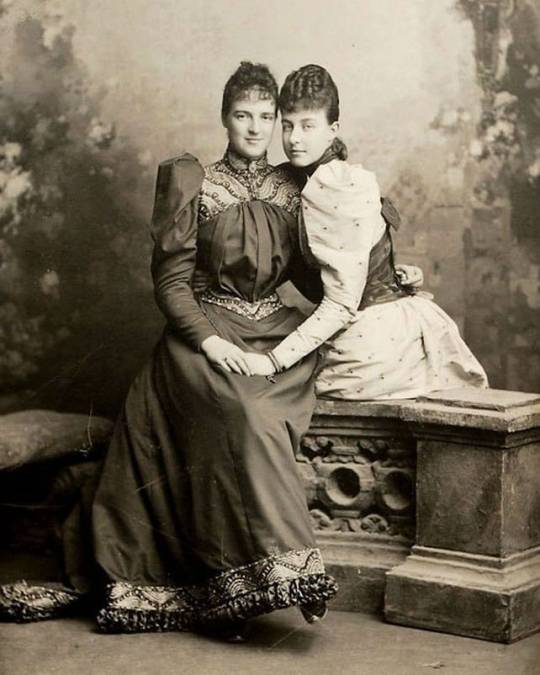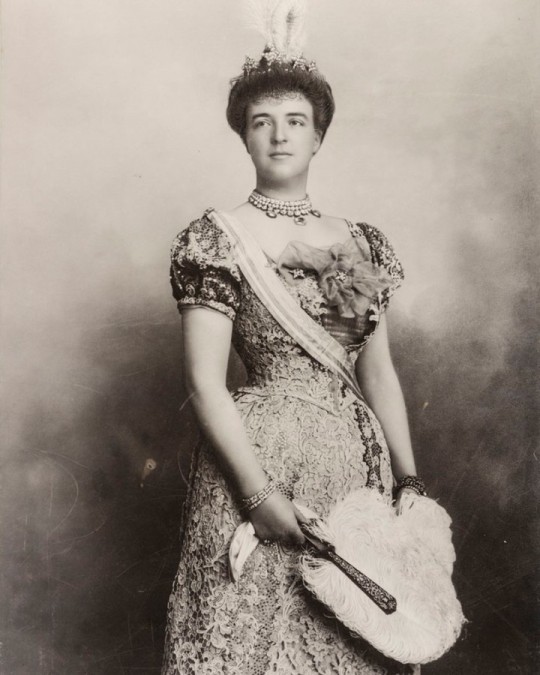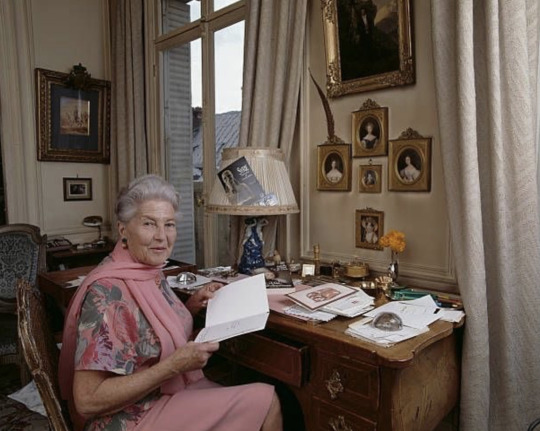#queen amelie of portugal
Text

Their Majesties, King Edward VII of the United Kingdom and Queen Amelie of Portugal
#king edward vii#queen amelie of portugal#british royal family#portuguese royal family#british history#portuguese history#house of saxe coburg and gotha#house of braganza
28 notes
·
View notes
Photo

The Queen of Portugal, Amelie, the eldest daughter of the Comte and Comtesse de Paris, is of English brith, for she was born at Twickenham in September 1865. She was married at the age of twenty-one in 1886, to Prince Charles of Portugal, who succeeded his father on the throne in 1889. They have two little sons, whose small features and fine texture of skin make them look slightly delicate, though they really are healthy children, with robust constitutions. The Crown Prince is named Louis Philippe, and is Duke of Braganza and also Duke of Saxony, and was born in 1887. His younger brother is Prince Manuel, Duke of Beja and of Saxony, and he is nearly five years old.
Cassell's Magazine, 1894
#Queen Amelie of Portugal#Infante Luis Filipe of Portugal#King Manuel II of Portugal#1890s#portuguese royal family#magazine article
10 notes
·
View notes
Text
A segment on Queen Amelie’s Diamond Tiara from TVI’s interview with Infanta Maria Francisca.

The tiara was a wedding gift from Queen Amelie’s father-in-law, King Luís, in 1886. They show a picture of it with the other wedding gifts from the Portuguese royal family all made by the crown jewelers, Leitão & Irmão. On the right is a matching necklace from her mother-in-law, Queen Maria Pia, and on the left is a sapphire and diamond necklace from her husband, the future King Carlos.

I’ve never seen a picture of Queen Amelie wearing the matching necklace and it was most likely dismantled to create her Diamond Choker Necklace that is still with the former Portuguese royal family. She was photographed on at least one occasion wearing the sapphire necklace but I’m not sure what happened to it.

Any Portuguese speakers, does the jewelry expert, Eduardo Alves Marques, give any more information or say anything interesting?
#Tiara Talk#jewel documentary#Portugal#Portuguese Royal Family#Infanta Maria Francisca#Queen Amelie#tiara#diamond
153 notes
·
View notes
Text

♔ Royal Wedding Tiaras ♔
Infanta Maria Francisca of Portugal:
Queen Amelie's Diamond Tiara
#infanta maria francisca#portugese royal family#royaltyedit#royal wedding#royal wedding tiaras#royal fashion#tiara#mine
16 notes
·
View notes
Text


Queen Amelie of Portugal (Princess of Orleans) with her little sister Princess Helene, 1890s.
#colorization#royalty#follow#explore#colourisation#queen amelie#princess helene#portuguese royals#french royals#orleans#1890s#victorian#victorian era#colored#historycolored
12 notes
·
View notes
Text

Portuguese Royal Family in 1900.
From left to right: King Carlos, Luís Filipe Prince Royal, Queen Maria Pia, Prince Manuel, Queen Amélie and Infante Afonso Duke of Porto.
#king carlos i of portugal#queen amelie of portugal#luís filipe prince royal of portugal#king manuel ii of portugal#dowager queen maria pia of portugal#infante afonso duke of porto#portuguese royalty#portuguese royal#portuguese royal family#1900s#1900
26 notes
·
View notes
Photo

Queen Amelie of Portugal, née Princess of Orleans, with her husband, Carlos, her firstborn son, Luis Filipe, her mother-in-law, born Princess Maria Pia of Savoy, and brother-in-law, Afonso, Duke of Porto, in 1888. Both Carlos and Luis Filipe were murdered on February 1, 1908.
#queen amelie of portugal#princess amelie of orleans#princess of orleans#queen of portugal#infanta#queen#Braganza#Saxe-Coburg and Gotha#king carlos I of portugal#king of portugal#portugal#king#queen maria pia of portugal#prince royal#prince#history
3 notes
·
View notes
Text

King Manuel of Portugal and his mother Queen Amelie in Lisboa, 1909.
He was the last King of Portugal, ascending the throne after the assasination of his father, King Carlos, and his elder brother, Prince Luis, the Prince Royal, on 1 February 1908.
23 notes
·
View notes
Photo

Amélie of Leuchtenberg (Amélie Auguste Eugénie Napoléone de Beauharnais), Empress of Brazil (31 July 1812 - 26 January 1873)
born in Milan to Eugène de Beauharnais, Duke of Leuchtenberg (1781-1824) and Augusta of Bavaria (1788-1851)
married Pedro I of Brazil (1798-1834) on 2 August 1829
had one child: Maria Amélia of Brazil (1831-1853)
died at the age of 60 in Lisbon, Kingdom of Portugal
#amelie of leuchtenberg#queen of portugal#empress of brazil#history#women in history#19th century#art#long live the queue
127 notes
·
View notes
Photo

THE PRINCESS
H.R.H. Princess Amelia d'Orleans, later Queen of Portugal (1865-1951)
#the princess#princess amelie d'orleans#queen amelia of portugal#portugal france#portuguese royal family#portuguese royalty#french royalty#orleans#bragança#braganza#royal#royals#royalty#royaltyedit
22 notes
·
View notes
Photo

King Luis Diamond Tiara ♕ Dom Duarte Pio, Duke of Braganza
#portugal#portuguese#portuguese royal family#português#dom duarte pio#duke of braganza#duchess of braganza#queen amelie#queen amelie of portugual#diamond tiara#royal jewels#diamond jewelry
144 notes
·
View notes
Text

Queen Amelia of Portugal
21 notes
·
View notes
Photo

Princess Amelie d’Orleans, later Queen of Portugal
36 notes
·
View notes
Text

TIARA ALERT: Infanta Maria Francisca of Portugal, Duchess of Coimbra, wore Queen Amelie's Diamond Tiara for her wedding to Duarte de Sousa Araújo Martins at the Basilica of Our Lady and Saint Anthony within the Palace of Mafra outside of Lisbon, Portugal on 7 October 2023.
#Tiara Alert#Infanta Maria Francisca#Portugal#Portuguese Royal Family#bridal tiara#tiara#diamond#diadem#House of Braganza#royal jewels
162 notes
·
View notes
Photo

800/830? Followers Gift!
Strathmore Rose Tiara - Queen Sophie of the Hellenes Diamond Tiara - Spanish Wedding Gift Tiara - Queen Amelie of Portugal’s Diamond Tiara - Marie Therese’s Emerald Tiara
I hit 800 followers last week and I planned to release it right away but I didn't have time, so instead im releasing it now! now I have 830 followers? so its an 830 followers gift now lol. thank you all for your kindness and support!
- BGC
- High Poly
- Hat Slider Compatible (Highly Recommended)
- Spanish Wedding Gift Tiara has 4 Swatches
Download
#sims 4 cc#my cc#mycc#Tiara#ts4 tiaras#ts4 hats#s4 hat cc#ts4 hat cc#custom content#cc#sims 4 custom content#s4 tiaras#sims 4 tiaras#tiara cc#sims tiaras#hat cc#sims 4 hat custom content#ts4 cc#ts4
538 notes
·
View notes
Photo

L’Histoire! Depuis mon enfance je pourrais dire que je n’ai cessé de trébucher sur elle! Nos aïeux, nos demeures, nos souvenirs, se confondent avec l’Histoire de France.**
- Isabelle, Comtesse de Paris
Isabelle Marie Amelie Louise Victoire Thérése Jeanne of Orléans and Bragança otherwise known as Isabelle, Comtesse of Paris, was a grand dame contemporary France. She was a renowned and stylish beauty, her photograph appeared in magazines throughout the world and she published biographies of ancestors who had been queens of France.
For many French royalists today her name today is still spoken with reverance. In many ways her death in 2003 at the ripe age of 92 years old was an an immeasurable loss to the French royalist cause. Her popularity was due to her character and that appeal was more favourably seen than the aloof haughtiness of its republican leaders from de Gaulle to Chirac.
When I have dinner with my French partner’s family and their circle of close knit friends her name often comes up as a way to lament the current crop of hapless Orléans descendents and how Republican France has lost its way.
I confess I didn’t know too much about her as she died around the time I was just a wee child. But living here in Paris as an adult (and foreign outsider) I have come across her ghost in late night laments over cigars and cognac as to what a wonderful and robust character she was from those who were her friends or knew her well.
In many ways such French royalists (a minority to be sure but still more than one might suppose) often believe that she would have made a worthy monarch than her hapless husband, Henri.

Indeed Isabelle was married for 68 years to the pretender to the French throne, Henri d'Orléans, the Comte de Paris ( who died in June 1999), whom she believed should have been Henri VI, King of France. She too was an Orléans, the great-great grandaughter of Louis-Philippe I, France's last king, who lost his throne in the revolution of 1848.
She was thus sometimes called the Princess of France, but, although tolerant of this indulgence, her loyalty was firmly to the royalist cause and to her husband's work.
Isabelle was born in 1911 at the Chateau d'Eu, in Normandy, where Queen Victoria and Prince Albert had been received in 1843 by Louis-Philippe and the first entente cordiale had been established. She was the eldest daughter of Pierre d'Orléans-Bragance, whose mother was the daughter of the Emperor of Brazil, and Elizabeth Dobrzenski, of an aristocratic Czech family.
She thus had a rich background, linked to the royal families of France, Portugal and Brazil, and to the old Bohemian aristocracy. All her life she cherished these connections, encouraging her own daughter to decorate her chateau of Le Lude, in the Sarthe, with a portrait of her ancestor, the Emperor Pedro II of Brazil.
Isabelle spent much of her childhood at the chateau d'Eu, and was educated by the sisters of Notre-Dame de Sion in Paris. In 1931, at the age of 19, she married her cousin Henri, who, since 1926, had been heir to the French throne.

The wedding had not been easy to arrange. By a law of 1886, those who claimed descent from a French monarch were not allowed to live in France, so the comte, who had been brought up in Morocco, Belgium and elsewhere, could not be married in France. He attempted to arrange the ceremony in Brussels but, apprehensive about royalist demonstrations there, the French persuaded the Belgians to refuse permission. In the end, the wedding took place in Palermo, Siciliy.
It was, none the less, a famous occasion. Many royal families were represented, and French royalists attended in their thousands, led by Charles Maurras and Léon Daudet of Action Francaise; it was widely reported that their cry was "Vive le Roi". The bride wore a dress by Worth, decorated with fleurs de lys.
Isabelle's famed good humour was tested by the complications of exile - for many years she and the comte stayed in Belgium, Brazil, Morocco and Spain, after sharing with relatives. The situation changed dramatically in 1950 when the government in Paris, beset by war in Indochina, repealed the 1866 law, and the comte and comtesse returned to live at Coer-Volant, a manor house in Louveciennes.

But still life had many difficulties. Isabelle's relations with her husband were often problematic, and they began to live apart. Henri was not an easy Pretender - he squandered a fortune, and not too discreetly kept a mistress. He was, after all, an Orleans as Isabelle stoically observed.
Henri was busy publishing news bulletins and negotiating with a wide range of politicians; at one point, he hoped to succeed General de Gaulle as president of France. Then he quarrelled with his eldest son and heir, and spent his money recklessly. But Isabelle never complained: "I'm sorry for my husband," she used to say. "I was never an obedient wife. I was too easily impatient." They separated in 1975; formally in 1986; but never divorced. Madame retained her dignity. When he died in 1999, Henri willed Isabelle any remaining worldly goods.
The saddest moment of her life was the death of her son François in 1960, while serving with the French army in Algeria. She said that his death was in the Orléanist tradition of serving France. Another of her sons, Thibert, died in a hunting accident in central Africa.

Isabelle was usually dressed in large hats, and wore a quadruple necklace of pearls. On special occasions, she also wore a famous sapphire and diamond tiara that had once belonged to the famous Marie-Antoinette. In addition to three volumes of memoirs, she published biographies of Marie-Amélie, the wife of Louis-Philippe I, and Marie-Antoinette.
She died in 2003 at the grand old age of 92. She was survived by nine of her 11 children, and more than 100 descendants. It has been said to me that none of her descendants have ever come close to her populist charisma, fun loving and good humour, quiet intelligence, chic style, genuine humility, and robust sense of noblesse oblige. Some have quietly withered away into bourgeois conformism, others into social obscurity, and a few morphing into spoiled Euro trash brats (the latter is well known to me from my Swiss boarding school days).

Her funeral was a cause of considerable widespread sadness. She had her faults of course but even here she was not lacking in self-awreness. She used to say, “"Cultivez vos défauts, c'est ce que vous avez de mieux." (Cultivate your faults, that’s the ebst you have). And yet even her most anti-royalist detractors noted their admiration for her down to earth good nature and easy charm. She was the nation’s favourite grandmother who stuffed your pockets with bonbons (candy) and told you how much you were loved as someone said in reflection. And that mischievous fun loving laugh, they still hear it today in some homes. As the grandmother of a friend who also was a good friend of Isabelle, Comtesse de Paris, put it, ““C’etait une grande dame....beaucoup de classe et de dignité. Elle aurait fait une bonne reine.”
**History! Since my childhood one could say that one never stopped stumbling on it! Our ancestors, our homes, our memories, merge with the History of France,
#isabelle#comtesse de Paris#orleans#monarchy#french#france#bourbon#henri d'orleans#royalty#republic#society#culture#personal
68 notes
·
View notes